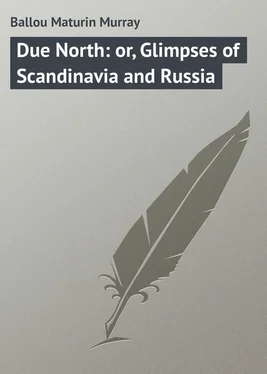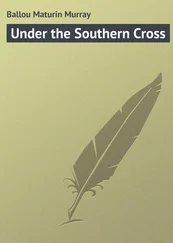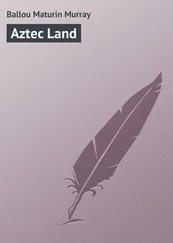Maturin Ballou - Due North - or, Glimpses of Scandinavia and Russia
Здесь есть возможность читать онлайн «Maturin Ballou - Due North - or, Glimpses of Scandinavia and Russia» — ознакомительный отрывок электронной книги совершенно бесплатно, а после прочтения отрывка купить полную версию. В некоторых случаях можно слушать аудио, скачать через торрент в формате fb2 и присутствует краткое содержание. Жанр: foreign_prose, Путешествия и география, на английском языке. Описание произведения, (предисловие) а так же отзывы посетителей доступны на портале библиотеки ЛибКат.
- Название:Due North: or, Glimpses of Scandinavia and Russia
- Автор:
- Жанр:
- Год:неизвестен
- ISBN:нет данных
- Рейтинг книги:3 / 5. Голосов: 1
-
Избранное:Добавить в избранное
- Отзывы:
-
Ваша оценка:
- 60
- 1
- 2
- 3
- 4
- 5
Due North: or, Glimpses of Scandinavia and Russia: краткое содержание, описание и аннотация
Предлагаем к чтению аннотацию, описание, краткое содержание или предисловие (зависит от того, что написал сам автор книги «Due North: or, Glimpses of Scandinavia and Russia»). Если вы не нашли необходимую информацию о книге — напишите в комментариях, мы постараемся отыскать её.
Due North: or, Glimpses of Scandinavia and Russia — читать онлайн ознакомительный отрывок
Ниже представлен текст книги, разбитый по страницам. Система сохранения места последней прочитанной страницы, позволяет с удобством читать онлайн бесплатно книгу «Due North: or, Glimpses of Scandinavia and Russia», без необходимости каждый раз заново искать на чём Вы остановились. Поставьте закладку, и сможете в любой момент перейти на страницу, на которой закончили чтение.
Интервал:
Закладка:
As to the fauna of Norway, the reindeer, the bear, the wolf, the fox, and the lynx about complete the list of indigenous animals. The ubiquitous crow abounds; and fine specimens of the golden eagle, that dignified monarch of the upper regions, may occasionally be seen sailing through the air from cliff to cliff, across the fjords and valleys. At certain seasons of the year this bird proves destructive to domestic fowls and young lambs. But we escaped in Norway the almost inevitable legend of a young child having been carried off by an eagle to its nearly inaccessible nest; that story is still monopolized by Switzerland. For some reason not quite understood by the author, the mischievous magpie is here held as half sacred. That is to say, the country people have a superstition that any injury inflicted upon these birds entails misfortune upon him who causes it; and yet the Government offers a premium for their destruction. Magpies appear to be as much of a nuisance in Norway as crows are in India or Ceylon, and to be quite as unmolested by the people generally. What are called the wild birds of Scandinavia are in fact remarkably tame, and they embrace a large variety. As the traveller proceeds through the country, he will observe sheaves of unthrashed grain elevated upon poles beside the farm-houses and barns, which are designed to furnish the feathered visitors with food. These sheaves are regularly renewed all through the winter season; otherwise the birds would starve. The confiding little creatures know their friends, and often enter the houses for protection from the severity of the weather. Neither man, woman, nor child would think of disturbing them, for they are considered as bringing good luck to the premises which they visit. The bounty paid for the destruction of bears and wolves in 1885 showed that nearly two hundred of each species of these animals were killed by the hunters. Bears are believed to be gradually decreasing, but wolves are still very numerous in the northerly regions and the thickly-wooded middle districts. In extreme seasons, when pressed by hunger, they prove destructive to the reindeer herds of the Lapps in spite of every ordinary precaution, and even in the summer season farmers never leave their sheep unguarded when they are pastured away from the homestead.
In journeying from the capital to Tröndhjem (where the steamer is taken for the North Cape) by the way of Lillehammer, one crosses the Dovrefjeld, or mountain plateau; but a more popular route is by rail from city to city. This fjeld lies a little above the sixty-second parallel of latitude, and is about one third of the distance from the southern to the northern extreme of the country, which reaches from the fifty-eighth to the seventy-first parallel. The famous elevation called the Sneehaettan – "Snow Hat" – forms a part of this Alpine range, and is one of the loftiest in Norway, falling little short of eight thousand feet in altitude. To be exact, it ranks sixth among the Scandinavian mountains. It should be remembered that one eighth of the country lies within the region of perpetual snow, and that these lofty and nearly inaccessible heights are robed in a constant garb of bridal whiteness. No other part of Europe or any inhabited portion of the globe has such enormous glaciers or snowfields, unless possibly some portions of Alaska. Here in Norway are glaciers which cover from four to five hundred square miles, descending from plateaus three and four thousand feet in height down to very near sea-level, as in the instance of the mammoth Svartisen glacier, which is visited by all travellers to the North Cape. Arctic and Alpine flowers abound in the region of the Dovrefjeld, – and glacial flowers are abundant, though not so much so as in the more frequently visited snow regions of Switzerland. As the ice and snow recede in the early summer, the plants spring up with magic promptness, so that within a few yards the same species are seen in successive stages of growth, spring and summer flowers blooming side by side in rather forced companionship. The blue gentians are extremely lovely, and are among the first to appear after the mantle of snow is lifted from the awaking earth. The most remarkable and abundant of the spring flowers however is the linnæa borealis , thus appropriately named after the great Swedish botanist and naturalist. It is a long, low-creeping plant bearing a pink blossom, and is in full bloom early in July, luxuriating all over the Scandinavian peninsula. Harebells nodding upon their delicate stems, primroses, snowdrops, and small blue pansies are also common. In the southern districts roses of various species thrive in glorious profusion in the open air annually during the short genial period, and also as domestic favorites during the long night of winter, adorning and perfuming the living-rooms of the people of every class in town and country.
Though the highest point in Norway or Sweden is only about eighty-five hundred feet above sea-level, an elevation which is reached only by the Jotunfjeld, or Giant Mountain, still no highlands in Europe surpass those of Scandinavia in terrific and savage grandeur, "rocked-ribbed and ancient as the sun." Mont Blanc is fully one third higher than this Giant Mountain, but being less abrupt is hardly so striking and effective in aspect. The grand elevations of Norway are intersected by deep dark gorges and fearful chasms, roaring with impetuous torrents and enormous waterfalls, and affording an abundance of such scenes as would have inspired the pencil of Salvator Rosa. The mountain system here does not form a continuous range, but consists of a succession of plateaus like the Dovrefjeld, and of detached mountains rising from elevated bases. The length of this series of peculiar elevations – mountains and plateaus – is that of the entire peninsula, from the North Cape to Christiansand on the Skager Rack, some twelve hundred miles, having an average width of about two hundred miles, – which gives to the mountains of Norway and Sweden an area larger than the Alps, the Apennines, and the Pyrenees combined, while the lakes, waterfalls, and cascades far surpass those of the rest of Europe. There is no other country where so large a portion is covered with august mountains as in Norway. It includes an area of about one hundred and twenty-three thousand square miles; and it has been said by those most familiar with its topography, that could it be flattened out it would make as large a division of the earth as would any of the four principal continents. The ratio of arable land to the entire area of Norway is not more than one to ten, and were it not that the support of the people at large comes mainly from the sea, the country could not sustain one quarter of even its present sparse population. Undismayed by the preponderance of rocks, cliffs, and chasms, the people utilize every available rod of land. Here and there are seen wire ropes extending from the low lands to the mountain sides, the upper ends of which are lost to sight, and which are used for sliding down bundles of compressed hay after it has been cut, made, and packed in places whither only men accustomed to scale precipices could possibly climb. The aspect of such regions is severe and desolate in the extreme, even when viewed beneath the cheering smiles of a summer sun. What then must be their appearance during the long, trying winter of these hyperborean regions? In snug corners, sheltered by friendly rocks and cliffs from the prevailing winds, are seen little clusters of cabins inhabited by a few lowly people who live in seeming content, and who rear families amid almost incredible deprivations and climatic disadvantages, causing one to wonder at their hardihood and endurance. It is not uncommon to see along the west coast of Norway, among the islands and upon the main-land, farm-houses surrounded by a few low buildings of the rudest character, perched among rocks away up on some lofty green terrace, so high indeed as to make them seem scarcely larger than an eagle's nest. To anybody but a mountaineer these spots are positively inaccessible, and every article of subsistence, except what is raised upon the few acres of available earth surrounding the house, must be carried up thither upon men's backs, for not even a mule could climb to these regions. A few goats and sheep must constitute the entire animal stock which such a spot can boast, with perhaps a few domestic fowls. These dwellings have been constructed of logs cut in some of the sheltered gulches near at hand and drawn to the spot with infinite labor, one by one. It would seem that such persistent and energetic industry applied in more inviting neighborhoods would have insured better results. What must life be passed in such an isolated, exposed place, in a climate where the ground is covered with snow for nine months of each year! Some few of these eyries have bridle-paths leading up to them which are barely passable; and yet such are thought by the occupants to be especially favored.
Читать дальшеИнтервал:
Закладка:
Похожие книги на «Due North: or, Glimpses of Scandinavia and Russia»
Представляем Вашему вниманию похожие книги на «Due North: or, Glimpses of Scandinavia and Russia» списком для выбора. Мы отобрали схожую по названию и смыслу литературу в надежде предоставить читателям больше вариантов отыскать новые, интересные, ещё непрочитанные произведения.
Обсуждение, отзывы о книге «Due North: or, Glimpses of Scandinavia and Russia» и просто собственные мнения читателей. Оставьте ваши комментарии, напишите, что Вы думаете о произведении, его смысле или главных героях. Укажите что конкретно понравилось, а что нет, и почему Вы так считаете.












